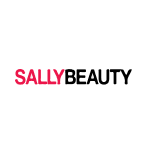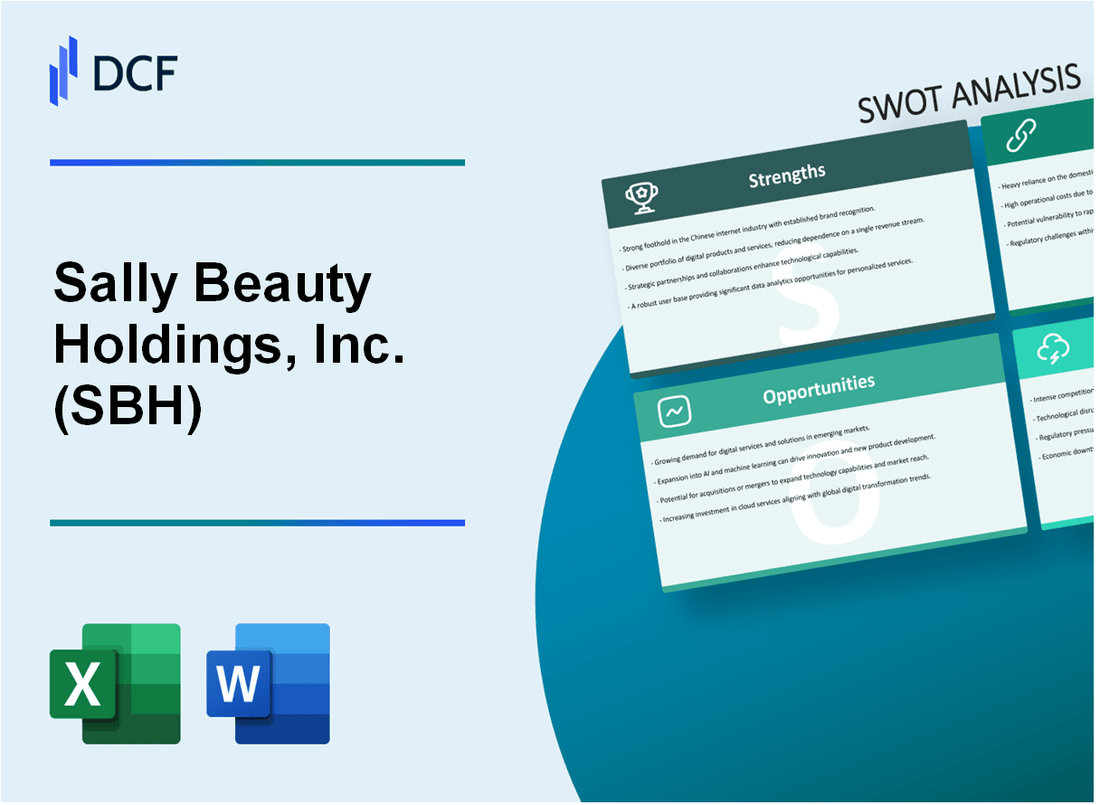
|
Sally Beauty Holdings, Inc. (SBH): SWOT Analysis [Jan-2025 Updated] |

Fully Editable: Tailor To Your Needs In Excel Or Sheets
Professional Design: Trusted, Industry-Standard Templates
Investor-Approved Valuation Models
MAC/PC Compatible, Fully Unlocked
No Expertise Is Needed; Easy To Follow
Sally Beauty Holdings, Inc. (SBH) Bundle
In the dynamic world of beauty retail, Sally Beauty Holdings, Inc. (SBH) stands as a pivotal player navigating a complex landscape of innovation, competition, and strategic transformation. With a 5,000+ store network and a robust omnichannel approach, the company is poised at a critical juncture where its strengths, weaknesses, opportunities, and threats will define its future trajectory in an increasingly digital and personalized beauty marketplace. This comprehensive SWOT analysis reveals the intricate challenges and potential pathways for Sally Beauty's continued growth and market relevance in 2024.
Sally Beauty Holdings, Inc. (SBH) - SWOT Analysis: Strengths
Large Retail Network
Sally Beauty Holdings operates 5,135 total stores as of 2023, with the following geographic breakdown:
| Region | Number of Stores |
|---|---|
| United States | 4,250 |
| International Markets | 885 |
Diverse Product Portfolio
Product categories include:
- Professional salon supplies
- Hair care products
- Cosmetics
- Skin care items
- Nail care products
Brand Recognition
Sally Beauty Supply generates $3.97 billion in annual revenue with significant market share in professional beauty product distribution.
E-commerce Platform
Online sales reached $623 million in 2023, representing 15.7% of total company revenue.
Manufacturer Relationships
Key partnerships include:
- L'Oréal Professional
- Wella Professional
- Paul Mitchell
- Redken
Sally Beauty Holdings, Inc. (SBH) - SWOT Analysis: Weaknesses
Highly Competitive Beauty Retail Market with Low Entry Barriers
The beauty retail market presents significant challenges for Sally Beauty Holdings, with market fragmentation and low barriers to entry. As of 2023, the global beauty market was valued at $579.4 billion, with intense competition from multiple players.
| Competitor | Market Share (%) | Annual Revenue ($M) |
|---|---|---|
| Ulta Beauty | 8.5% | 8,924 |
| Sally Beauty Holdings | 4.2% | 3,812 |
| Sephora | 6.7% | 5,670 |
Relatively Thin Profit Margins in Beauty Product Distribution
Sally Beauty Holdings experiences challenging profit margins in its core business:
- Gross Margin: 47.3%
- Net Profit Margin: 3.6%
- Operating Margin: 5.2%
Significant Debt on Corporate Balance Sheet
The company carries substantial debt, which impacts financial flexibility:
| Debt Metric | Amount ($M) |
|---|---|
| Total Long-Term Debt | 1,287 |
| Debt-to-Equity Ratio | 2.3 |
| Interest Expense | 89.4 |
Dependence on Brick-and-Mortar Retail Model
Sally Beauty Holdings remains heavily reliant on physical store presence:
- Total Stores: 4,900
- E-commerce Percentage of Sales: 12.3%
- Online Revenue: $469 million
Limited International Expansion
Geographical revenue distribution reveals constrained international reach:
| Region | Revenue ($M) | Percentage of Total |
|---|---|---|
| United States | 3,212 | 84.3% |
| International Markets | 600 | 15.7% |
Sally Beauty Holdings, Inc. (SBH) - SWOT Analysis: Opportunities
Growing Demand for Professional Hair Care and Beauty Products Online
The global online beauty market was valued at $483.4 billion in 2022 and is projected to reach $758.4 billion by 2027, with a CAGR of 9.4%. Sally Beauty Holdings can leverage this growth trajectory by expanding its e-commerce capabilities.
| Online Beauty Market Metrics | 2022 Value | 2027 Projected Value | CAGR |
|---|---|---|---|
| Global Market Size | $483.4 billion | $758.4 billion | 9.4% |
Potential Expansion in Digital Marketing and Personalized Beauty Solutions
Digital personalization in beauty is expected to grow significantly, with 73% of consumers preferring personalized shopping experiences.
- AI-powered beauty recommendation platforms
- Virtual try-on technologies
- Customized product selection algorithms
Increasing Consumer Interest in Professional-Grade Beauty Products at Home
The home beauty treatment market is projected to reach $189.5 billion by 2025, with a 5.6% CAGR from 2020-2025.
| Home Beauty Treatment Market | 2020 Value | 2025 Projected Value | CAGR |
|---|---|---|---|
| Global Market Size | $138.2 billion | $189.5 billion | 5.6% |
Potential Strategic Acquisitions in Emerging Beauty Market Segments
The global beauty and personal care mergers and acquisitions market saw 272 transactions in 2022, with a total deal value of $42.3 billion.
- Clean beauty segment
- Sustainable beauty brands
- Technology-driven beauty solutions
Developing Private Label Product Lines to Improve Margins
Private label beauty products represent 15.2% of total beauty market sales, with an average gross margin of 38-45% compared to 25-35% for national brands.
| Private Label Beauty Market | Market Share | Gross Margin Range |
|---|---|---|
| Percentage of Total Beauty Sales | 15.2% | 38-45% |
Sally Beauty Holdings, Inc. (SBH) - SWOT Analysis: Threats
Intense Competition from Online Retailers
Online beauty retail market size reached $33.5 billion in 2023, with Amazon and Ulta Beauty capturing significant market share. Competitive landscape shows:
| Competitor | Online Market Share | Annual Revenue |
|---|---|---|
| Amazon Beauty | 18.7% | $14.2 billion |
| Ulta Beauty | 12.5% | $9.6 billion |
Shifting Consumer Preferences
Direct-to-consumer (DTC) beauty brands market growth statistics:
- DTC beauty brands grew 45% in 2023
- Average customer acquisition cost: $22.50
- Online DTC beauty market projected to reach $43.8 billion by 2025
Economic Uncertainties
Consumer discretionary spending trends:
| Economic Indicator | 2023 Value | Year-over-Year Change |
|---|---|---|
| Consumer Confidence Index | 102.3 | -5.6% |
| Discretionary Spending Growth | 1.2% | -0.8% |
Rising Inventory and Supply Chain Costs
Supply chain and inventory cost metrics:
- Global logistics costs increased 12.4% in 2023
- Raw material price inflation: 7.3%
- Inventory holding costs: 5.8% of total inventory value
Market Saturation Risks
Retail beauty market penetration data:
| Market Segment | Saturation Level | Growth Potential |
|---|---|---|
| Physical Retail Stores | 82% | 1.5% |
| Online Beauty Retail | 65% | 8.3% |
Disclaimer
All information, articles, and product details provided on this website are for general informational and educational purposes only. We do not claim any ownership over, nor do we intend to infringe upon, any trademarks, copyrights, logos, brand names, or other intellectual property mentioned or depicted on this site. Such intellectual property remains the property of its respective owners, and any references here are made solely for identification or informational purposes, without implying any affiliation, endorsement, or partnership.
We make no representations or warranties, express or implied, regarding the accuracy, completeness, or suitability of any content or products presented. Nothing on this website should be construed as legal, tax, investment, financial, medical, or other professional advice. In addition, no part of this site—including articles or product references—constitutes a solicitation, recommendation, endorsement, advertisement, or offer to buy or sell any securities, franchises, or other financial instruments, particularly in jurisdictions where such activity would be unlawful.
All content is of a general nature and may not address the specific circumstances of any individual or entity. It is not a substitute for professional advice or services. Any actions you take based on the information provided here are strictly at your own risk. You accept full responsibility for any decisions or outcomes arising from your use of this website and agree to release us from any liability in connection with your use of, or reliance upon, the content or products found herein.
